
The family Alligatoridae of crocodylians includes alligators, caimans and their extinct relatives.
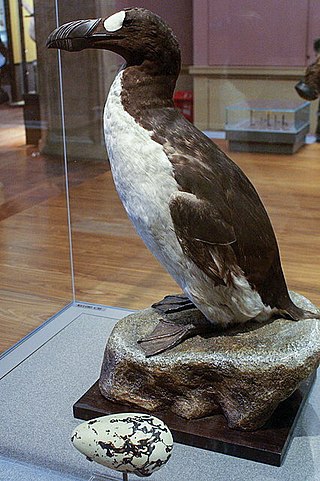
The great auk, also known as the penguin or garefowl, is a species of flightless alcid that became extinct in the mid-19th century. It was the only modern species in the genus Pinguinus. It is unrelated to the penguins of the Southern Hemisphere, which were named for their resemblance to this species.

Auks or alcids are a group of birds of the family Alcidae in the order Charadriiformes. The alcid family includes the murres, guillemots, auklets, puffins, and murrelets. The family contains 25 extant or recently extinct species that are divided into 11 genera. Auks are found throughout the Northern Hemisphere.

The spider family Liphistiidae was first recognized by Tamerlan Thorell in 1869. When narrowly circumscribed, it comprises a single genus Liphistius, native to Southeast Asia; as of April 2024, this was the circumscription accepted by the World Spider Catalog. The family contains the most basal living spiders, belonging to the suborder Mesothelae. The family has also been circumscribed more broadly to include the family Heptathelidae as a subfamily, Heptathelinae, with the narrowly circumscribed Liphistiidae becoming the subfamily Liphistiinae.

The black guillemot or tystie is a medium-sized seabird of the Alcidae family, native throughout northern Atlantic coasts and eastern North American coasts. It is resident in much of its range, but large populations from the high arctic migrate southwards in winter. The bird can be seen in and around its breeding habitat of rocky shores, cliffs and islands in single or smalls groups of pairs. They feed mainly by diving towards the sea floor feeding on fish, crustaceans or other benthic invertebrates. They are listed on the IUCN red list as a species of least concern.

The razorbill, razor-billed auk, or lesser auk is a North Atlantic colonial seabird and the only extant member of the genus Alca of the family Alcidae, the auks. It is the closest living relative of the extinct great auk. Historically, it has also been known as "auk", "razor-billed auk" and "lesser auk".

The Atelidae are one of the five families of New World monkeys now recognised. It was formerly included in the family Cebidae. Atelids are generally larger monkeys; the family includes the howler, spider, woolly, and woolly spider monkeys. They are found throughout the forested regions of Central and South America, from Mexico to northern Argentina.

Sule Stack or Stack Skerry is an extremely remote island or stack in the North Atlantic off the north coast of Scotland. It is formed of Lewisian gneiss.

The Brisons is a twin-peaked islet in the Celtic Sea situated 1 mile (1.6 km) offshore from Cape Cornwall in Cornwall, on the south-western coast of Great Britain.
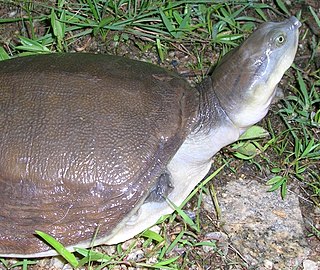
Lissemys is a genus of softshell turtles in the subfamily Cyclanorbinae of the family Trionychidae. The genus is indigenous to southern Asia.

Dr. Laurence Edmondston was a Scottish-born naturalist and doctor who was from Shetland, Scotland, United Kingdom.

Feliformia is a suborder within the order Carnivora consisting of "cat-like" carnivorans, including cats, hyenas, mongooses, viverrids, and related taxa. Feliformia stands in contrast to the other suborder of Carnivora, Caniformia.
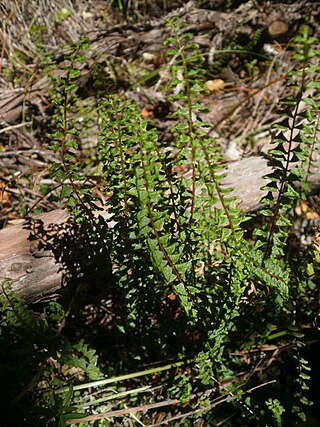
Lindsaeaceae is a pantropical family of ferns in the order Polypodiales. It contains six or seven genera with about 220 known species, some of which also extend into the more temperate regions of eastern Asia, New Zealand, and South America.
Eucyon ferox is a species of canid which was endemic to North America and lived during the late Hemphillian age. Originally described as a species of the extant genus Canis, this animal was thought to be an ancestor of the modern day coyote, but recent taxonomic revision has reassigned this species to the extinct genus Eucyon.
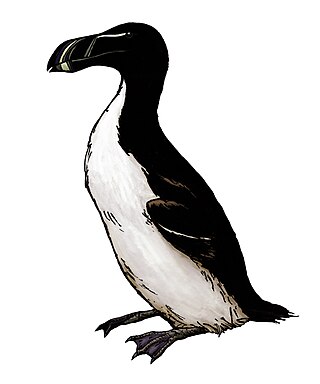
Pinguinus alfrednewtoni is an extinct species of auk related to the great auk known from fossils that were discovered in the Pliocene Yorktown Formation of North Carolina. Like the great auk, it was a large flightless diving bird that used its wings to propel itself forward underwater. Only a limited amount of material is known, despite the rich diversity of fossil auks recovered from the Yorktown Formation. Due to this, it has been proposed that it was either a more coastal animal or simply not as common in more southern waters. This later suggestion could be supported by the discovery of relatively young P. alfrednewtoni remains, indicating that they may have overwintered in the region. One early hypothesis proposed that it was a direct ancestor to the great auk, but this idea is no longer supported. Instead, it is thought that it filled the same niche as its eastern relative, which eventually expanded into the western Atlantic after the extinction of P. alfrednewtoni.
Gretagrund is a shoal located a few km southeast of Ruhnu island in the Gulf of Riga, Estonia.
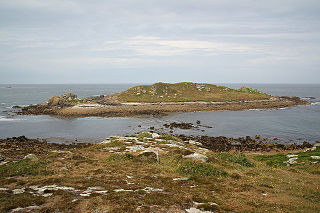
The Norrard (Northern) Rocks are a group of small uninhabited granite rocks in the north–western part of the Isles of Scilly, to the west of Bryher and Samson. In 1971 they were designated as a Site of Special Scientific Interest (SSSI) for their breeding seabird colonies and they are permanently closed to landings from boat passengers. The vegetation on the islands is limited by the extreme exposure and only six species of flowering plants have been recorded.
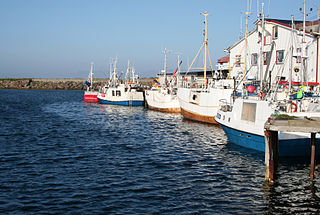
Stø is a fishing village in Øksnes Municipality in Nordland county, Norway. It is located on the northern tip of the island of Langøya, along the Gavlfjorden in the Vesterålen archipelago. In 2001, there were about 175 residents. This village was the administrative centre of the old Langenes Municipality which existed from 1919 until 1964.

Lågskär is a small island within the Åland archipelago of Finland. It belongs to the municipality of Lemland. It is situated about 24 kilometres (15 mi) south of Mariehamn in the Baltic's Sea of Åland. The main island of Lågskär measures 61 hectares in area. Rock stacks, sea cliffs and rocky shores are found along the coastline of the island. As a breeding ground for waterfowl, Lågskär has the status of an Important Bird Area (IBA) and is frequented by ornithologists who use the Lågskär Lighthouse buildings during their stay. In the past, several vessels have sunk off the coast.

Caruso brachysomus is an extinct species of ray-finned fish belonging to the family Lophiidae, the goosefishes, monkfishes and anglers, within the order Lophiiformes, the anglerfishes. It was described by Louis Agassiz in 1835 from the Monte Bolca locality. It became extinct during the middle Eocene.




















